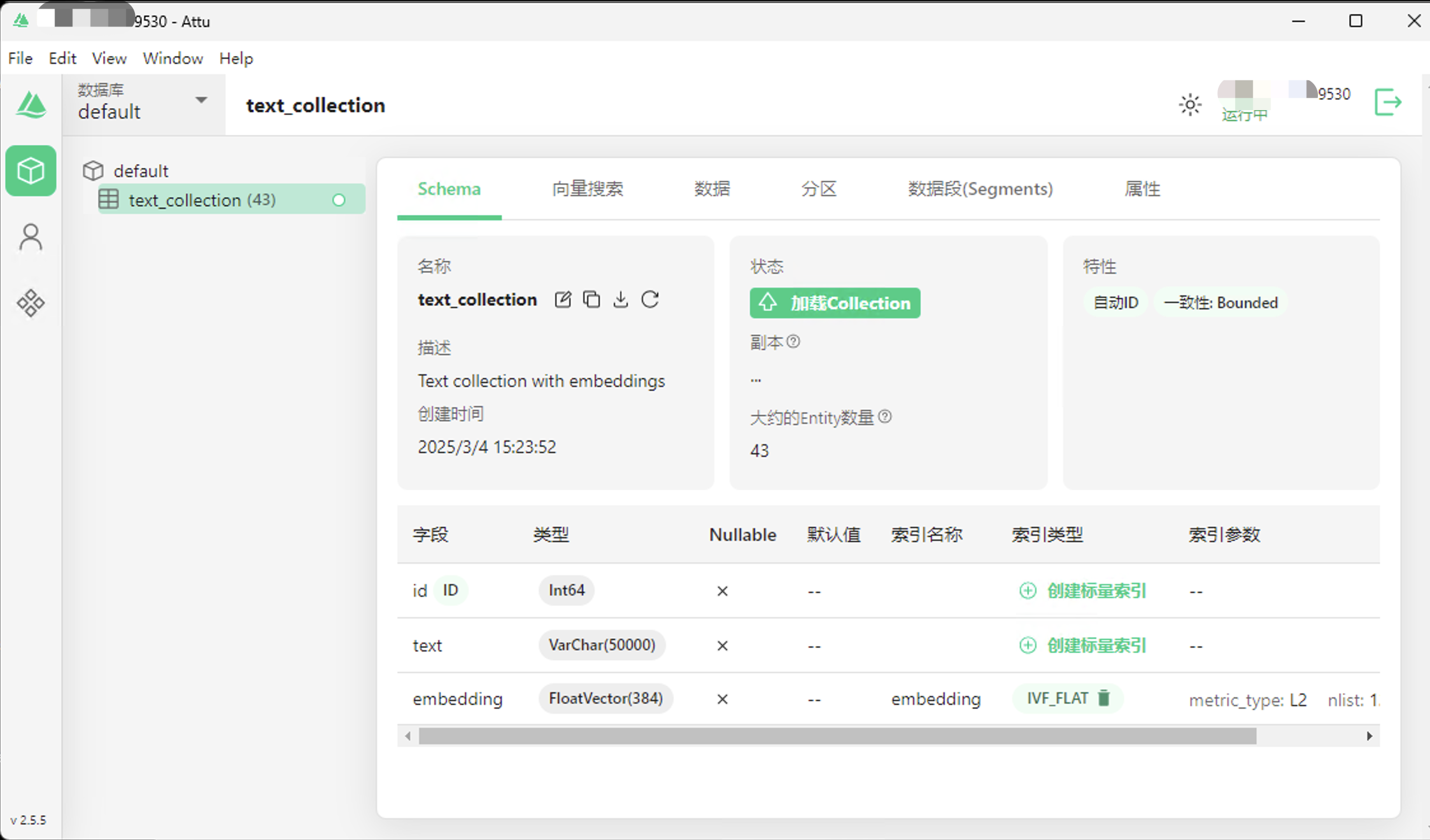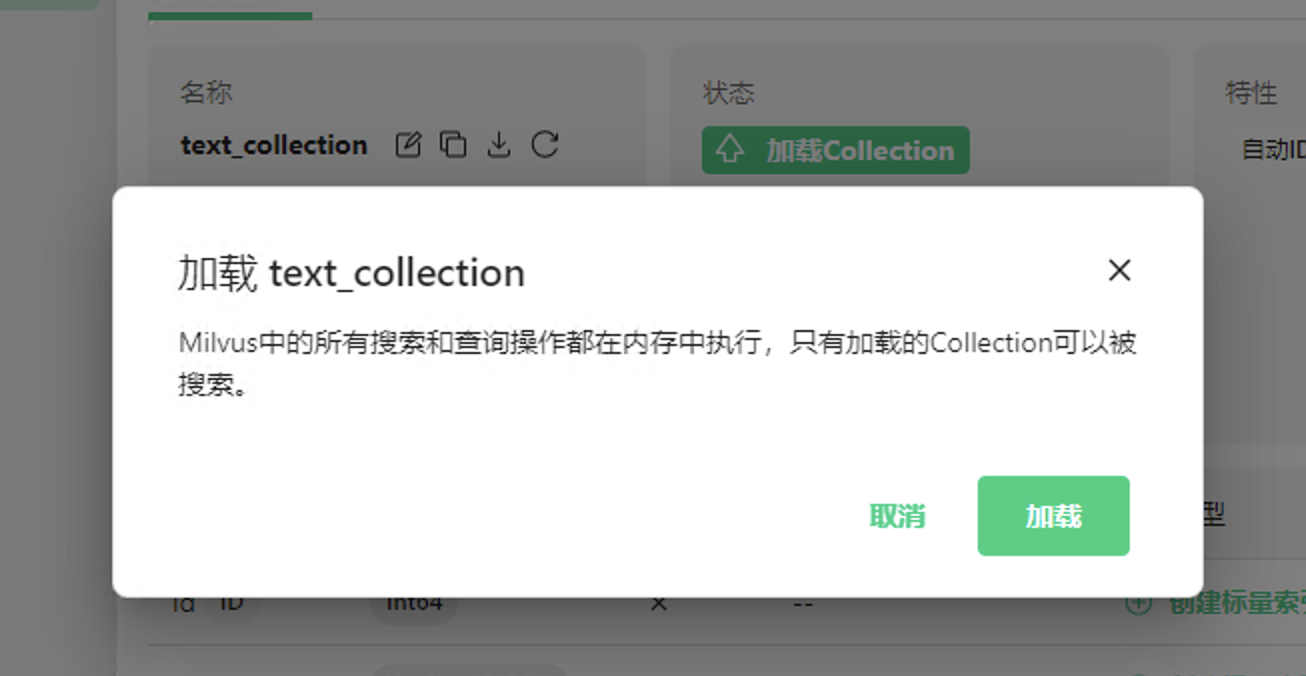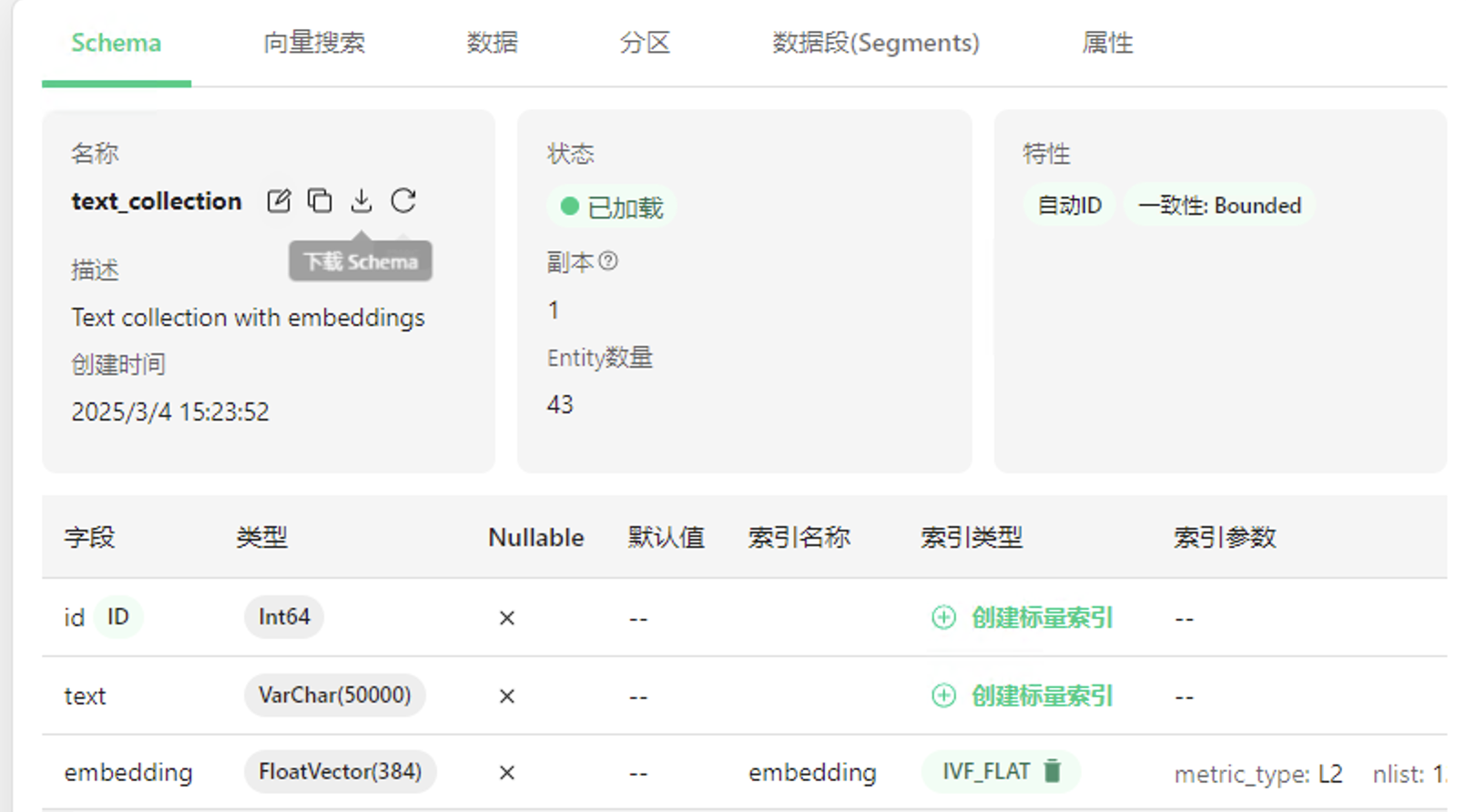一、首先部署个本地向量数据库,这里使用milvus为例,本地创建一个docker-compose.yaml
version: '3.5'
services:
etcd:
container_name: milvus-etcd
image: quay.io/coreos/etcd:v3.5.18
environment:
- ETCD_AUTO_COMPACTION_MODE=revision
- ETCD_AUTO_COMPACTION_RETENTION=1000
- ETCD_QUOTA_BACKEND_BYTES=4294967296
- ETCD_SNAPSHOT_COUNT=50000
volumes:
- ${DOCKER_VOLUME_DIRECTORY:-.}/volumes/etcd:/etcd
command: etcd -advertise-client-urls=http://127.0.0.1:2379 -listen-client-urls http://0.0.0.0:2379 --data-dir /etcd
healthcheck:
test: ["CMD", "etcdctl", "endpoint", "health"]
interval: 30s
timeout: 20s
retries: 3
minio:
container_name: milvus-minio
image: minio/minio:RELEASE.2023-03-20T20-16-18Z
environment:
MINIO_ACCESS_KEY: minioadmin
MINIO_SECRET_KEY: minioadmin
ports:
- "9001:9001"
- "9000:9000"
volumes:
- ${DOCKER_VOLUME_DIRECTORY:-.}/volumes/minio:/minio_data
command: minio server /minio_data --console-address ":9001"
healthcheck:
test: ["CMD", "curl", "-f", "http://localhost:9000/minio/health/live"]
interval: 30s
timeout: 20s
retries: 3
standalone:
container_name: milvus-standalone
image: milvusdb/milvus:v2.5.5
command: ["milvus", "run", "standalone"]
security_opt:
- seccomp:unconfined
environment:
ETCD_ENDPOINTS: etcd:2379
MINIO_ADDRESS: minio:9000
volumes:
- ${DOCKER_VOLUME_DIRECTORY:-.}/volumes/milvus:/var/lib/milvus
healthcheck:
test: ["CMD", "curl", "-f", "http://localhost:9091/healthz"]
interval: 30s
start_period: 90s
timeout: 20s
retries: 3
ports:
- "19530:19530"
- "9091:9091"
depends_on:
- "etcd"
- "minio"
networks:
default:
name: milvus通过docker-compose up -d 启动应用

在pycharm中创建项目,代码如下
from pymilvus import connections, FieldSchema, CollectionSchema, DataType, Collection, utility
from sentence_transformers import SentenceTransformer
import os
# 配置参数
MILVUS_HOST = "服务端地址"
MILVUS_PORT = "19530"
COLLECTION_NAME = "text_collection"
DIMENSION = 384 # 模型向量维度(根据模型调整)
BATCH_SIZE = 128 # 批量插入大小
TEXT_FILE_PATH = "test.txt" # 替换为你的文本文件路径
grpc_options = {
"grpc.max_send_message_length": 100 * 1024 * 1024 * 100, # 100MB
"grpc.max_receive_message_length": 100 * 1024 * 1024 * 100, # 100MB
}
# 1. 连接 Milvus
connections.connect(host=MILVUS_HOST, port=MILVUS_PORT,grpc_options=grpc_options)
# 2. 创建 Collection
def create_collection():
if utility.has_collection(COLLECTION_NAME):
utility.drop_collection(COLLECTION_NAME)
fields = [
FieldSchema(name="id", dtype=DataType.INT64, is_primary=True, auto_id=True),
FieldSchema(name="text", dtype=DataType.VARCHAR, max_length=50000),
FieldSchema(name="embedding", dtype=DataType.FLOAT_VECTOR, dim=DIMENSION)
]
schema = CollectionSchema(fields, description="Text collection with embeddings")
collection = Collection(name=COLLECTION_NAME, schema=schema)
# 创建索引
index_params = {
"index_type": "IVF_FLAT",
"metric_type": "L2",
"params": {"nlist": 128}
}
collection.create_index("embedding", index_params)
return collection
# 3. 加载文本并生成向量
def process_text(file_path):
# 读取文本文件
with open(file_path, 'r', encoding='utf-8') as f:
texts = [line.strip() for line in f if line.strip()]
# 初始化模型(这里使用小型 sentence-BERT 模型)
model = SentenceTransformer('all-MiniLM-L6-v2')
# 批量生成向量
embeddings = model.encode(texts, batch_size=BATCH_SIZE, show_progress_bar=True)
return texts, embeddings
# 4. 插入数据到 Milvus
def insert_data(collection, texts, embeddings,batch_size=1000):
total = len(texts)
for start in range(0, total, batch_size):
end = min(start + batch_size, total)
batch_texts = texts[start:end]
# 如果 embeddings 是 numpy 数组,则转换为列表格式
batch_embeddings = embeddings[start:end].tolist()
entities = [
batch_texts,
batch_embeddings
]
insert_result = collection.insert(entities)
collection.flush() # 确保数据持久化
print(f"Inserted records from {start} to {end - 1}")
def search_similar(collection, query_text, top_k=5):
# 向量化查询文本
model = SentenceTransformer('paraphrase-multilingual-mpnet-base-v2')
query_embedding = model.encode([query_text]).tolist()
# 配置搜索参数
search_params = {"metric_type": "L2", "params": {"nprobe": 10}}
# 执行搜索
results = collection.search(
data=query_embedding,
anns_field="embedding",
param=search_params,
limit=top_k,
output_fields=["text"] # 返回原始文本
)
# 解析结果
for hits in results:
for hit in hits:
print(f"ID: {hit.id}, Distance: {hit.distance}, Text: {hit.entity.get('text')}")
# 使用示例
def query():
query_text = "vCenter Server主要作用"
# collection = create_collection()
model = SentenceTransformer('all-MiniLM-L6-v2')
collection = Collection("text_collection")
collection.load() # 确保数据加载到内存
uery_text = "需要查询的关键词或句子"
query_vector = model.encode([query_text]).tolist() # 转换为列表格式
# 执行搜索
search_params = {
"metric_type": "L2", # 需与索引的 metric_type 一致
"params": {"nprobe": 32} # 调整 nprobe 平衡精度与速度
}
results = collection.search(
data=query_vector,
anns_field="embedding", # 指定向量字段名
param=search_params,
limit=5, # 返回前5条结果
output_fields=["text"] # 同时返回原始文本字段
)
# 解析结果
for hits in results:
print(f"找到 {len(hits)} 条相关记录:")
for hit in hits:
print(f"""
ID: {hit.id}
相似距离: {hit.distance:.4f}
文本内容: {hit.entity.get('text')}
""")
def create_collection():
collection = create_collection()
# 处理文本数据
texts, embeddings = process_text(TEXT_FILE_PATH)
# 插入数据
insert_data(collection, texts, embeddings)
# 验证数据量
print("Total entities:", collection.num_entities)
# 主流程
if __name__ == "__main__":
query()
其中,文本内容如下
以下是关于 vCenter 的详细概念说明:
---
### 1. 基本概念
**vCenter Server** 是 VMware 虚拟化平台 vSphere 的核心管理组件,它提供了一个集中式的管理界面,用于管理整个虚拟化环境中的所有资源,包括 ESXi 主机、虚拟机、存储和网络等。vCenter 通过一个统一的控制台,简化了对大规模数据中心的管理工作,使管理员能够从单一位置监控和配置所有虚拟化资源。
---
### 2. 主要功能
- **集中管理**
vCenter 允许管理员在单一平台上统一管理所有 ESXi 主机和虚拟机,无需逐台主机登录,极大地提升了管理效率。
- **资源调度与优化**
- **Distributed Resource Scheduler (DRS):** 根据资源利用率和工作负载,自动平衡主机之间的负载,优化资源分配。
- **Storage DRS:** 在存储资源之间进行负载均衡,确保存储性能和容量的合理分配。
- **vMotion:** 支持虚拟机在 ESXi 主机之间的实时迁移,无需停机,从而实现无缝的维护和负载均衡。
- **高可用性和灾备**
- **vSphere High Availability (HA):** 当某台 ESXi 主机发生故障时,自动重启受影响的虚拟机到其他主机上运行。
- **Fault Tolerance (FT):** 为关键任务的虚拟机提供无停机时间的故障保护,确保在硬件故障时业务不中断。
- **性能监控与报告**
内置的监控工具能够实时追踪虚拟机和主机的性能指标(如 CPU、内存、网络、存储使用率),并生成详细的报告,帮助管理员及时发现和解决问题。
- **备份与恢复管理**
虽然 vCenter 本身不直接负责备份,但它提供了与各种备份解决方案的集成接口,便于虚拟机数据的定期备份和快速恢复。
---
### 3. 架构和部署
- **部署形式**
vCenter Server 可以部署为基于 Windows 的应用程序或作为预配置的虚拟设备(vCenter Server Appliance, VCSA),后者在性能、维护和安全性方面通常具有更好的表现。
- **组件结构**
- **vCenter Server:** 核心服务,负责管理和调度所有虚拟化资源。
- **vSphere Client:** 用户通过它连接到 vCenter,以图形化界面管理虚拟化环境。
- **其他支持组件:** 包括 Single Sign-On (SSO)、Web 服务、数据库服务等,确保整个系统的高效协同工作。
---
### 4. 应用场景与优势
- **数据中心管理**
在企业级数据中心中,vCenter 能够帮助管理员高效管理数十到数百台 ESXi 主机和成千上万的虚拟机。
- **云计算平台建设**
通过集中资源管理和自动化调度,vCenter 为私有云和混合云平台提供了坚实的基础。
- **高可用性和业务连续性**
利用 HA、vMotion 等特性,vCenter 能够在硬件故障或维护期间实现业务的无缝迁移和快速恢复,确保系统连续运行。
- **资源优化与成本控制**
自动化的资源调度和性能监控帮助企业合理分配资源,避免资源浪费,同时提升整体系统性能和利用率。
---
### 总结
vCenter 是 VMware 虚拟化架构中的核心组件,凭借其集中管理、自动化资源调度和高可用性支持,为大规模虚拟化环境提供了高效、可靠的管理平台。无论是在数据中心运营、云平台建设还是业务连续性保障方面,vCenter 都发挥着至关重要的作用,帮助企业实现 IT 基础设施的优化和成本控制。
---
这种集中管理和智能调度的能力,使 vCenter 成为现代 IT 环境中不可或缺的管理工具,为企业带来更高的运维效率和业务连续性保障。
运行代码,将文本数据写入向量数据库中
if __name__ == "__main__":
create_collection()
通过客户端查看已经写入

点击加载Collection按钮


执行查询语句
if __name__ == "__main__":
# create_collection()
query()结果如下,后续可以使用其他模型进行优化
找到 5 条相关记录:
ID: 456388602814760353
相似距离: 0.2757
文本内容: - vCenter Server: 核心服务,负责管理和调度所有虚拟化资源。
ID: 456388602814760351
相似距离: 0.3191
文本内容: vCenter Server 可以部署为基于 Windows 的应用程序或作为预配置的虚拟设备(vCenter Server Appliance, VCSA),后者在性能、维护和安全性方面通常具有更好的表现。
ID: 456388602814760332
相似距离: 0.3611
文本内容: vCenter Server 是 VMware 虚拟化平台 vSphere 的核心管理组件,它提供了一个集中式的管理界面,用于管理整个虚拟化环境中的所有资源,包括 ESXi 主机、虚拟机、存储和网络等。vCenter 通过一个统一的控制台,简化了对大规模数据中心的管理工作,使管理员能够从单一位置监控和配置所有虚拟化资源。
ID: 456388602814760368
相似距离: 0.4737
文本内容: vCenter 是 VMware 虚拟化架构中的核心组件,凭借其集中管理、自动化资源调度和高可用性支持,为大规模虚拟化环境提供了高效、可靠的管理平台。无论是在数据中心运营、云平台建设还是业务连续性保障方面,vCenter 都发挥着至关重要的作用,帮助企业实现 IT 基础设施的优化和成本控制。
ID: 456388602814760354
相似距离: 0.4896
文本内容: - vSphere Client: 用户通过它连接到 vCenter,以图形化界面管理虚拟化环境。


评论区